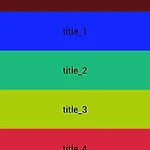목록Android (496)
오늘도 공부
출처 : http://nlopez.io/how-to-style-the-actionbar-searchview-programmatically/I stumbled upon a problem with the styling of a view at work. I had almost everything solved with a custom theme, but it all came down to style a SearchView widget of an ActionBar.That's where the fun begins.All of this must happen in your onCreateOptionsMenu method. With a reference to your SearchView object in there, ..
앞페이지에서 옵션메뉴를 하였다 옵션메뉴는 전화기의 하단 왼쪽 화면 밖을 크릭하면 나타나는 것 프로그램들 마다 다양한 형식의 메뉴시스템을 제공하듯이 안드로이드에는 이것만 있는 것이 아니고 윈도우시스템의 상단 메뉴줄과 같은 것도 있을 것이다 이것을 Action Bar라고 부른다 이번 페이지에서는 Action Bar에 앞의 페이지에서 만든 것을 옮겨 보자 아주 간단하다 위의 메뉴를 구성하는 xml화일을 Activity 크래스의 아래 메소드에서 불러 들여서 옵션메뉴를 설치하였던 것이다 public boolean onCreateOptionsMenu(Menu menu) { MenuInflater menuInflater = getMenuInflater(); menuInflater.inflate(R.menu.activ..
출처 : http://bugnote.tistory.com/2 안드로이드 프로그래밍을 하던 중 사용자와 사용자간의 거리를 계산해야 할 일이 생겼다.각 사용자의 위치는 위도와 경도로 알고 있기 때문에 아래 공식을 이용하여 적용했다.좌표 1(위도,경도)과 좌표 2(위도,경도) 거리 계산 방법sLat,sLng 는 좌표1(로그인한 사용자)의 위도, 경도 값이다.double sLat = Double.valueOf(LoginUser.item.lat); double sLng = Double.valueOf(LoginUser.item.lng);eLat, eLng는 대상(target)의 위도,경도 값이다. double eLat = Double.valueOf(item.lat); double eLng = Double.value..
출처 : http://ncube.net/7388이번에 작업 중인 사이트.. 수시로 정책이 바뀌어서 고생하고 있는.. 사이트에서 반경을 이용한 업체 검색 기능이 필요해서 구글링 좀 하고 잔머리를 좀 굴려서 원하는 기능을 구현했다. 각 지점의 경도와 위도는 네이버 지도API를 이용해 얻어온다. 그런 다음 경도 위도를 DB에 저장하고 Query를 이용해 기준 반경 내 업체를 구하는 식이다.1. 네이버 지도 API에서 경도, 위도 받아오기 우선 네이버 지도 API를 이용하기 위해서는 Key를 등록해야 한다. http://dev.naver.com/openapi/register 에 접속한다. 로그인이 되어야 정상적으로 이용할 수 있다. 그런 다음 아래 화면처럼 지도키 발급에서 사이트 주소를 입력하고 키를 발급받도록..
출처 : http://blog.naver.com/blow1/150106632098 해당 위도와 경도가 주어진 구역반경에 들어오는지 체크 한다. 아래는 위,경도를 통한 도분초를 계산하는 방법이며 마지막에 실제 함수를 작성하였다. 구글 거리계산기와 아래 함수를 비교하여 보니 정확한 계산치를 확인 할 수 있었다. 하지만, 아래 계산법은 우리 나라에 한해서만 적용되어야 할 듯 하다.( 서핑 하다 보니 이러저러한 이유로 지구 전체에 대한 것은 좀더 상세한 계산법이 필요 할 듯 하다) lat : 위도 , lon: 경도. ex>35.3036944 도 : 35 분 : 0.3036944 * 60 : int : 18 초 : (0.3036944 * 60 - 18)*60 : 13.3 35도 18분 13.3초 A 지점 : 동경..
출처 : http://ggari.tistory.com/229 안드로이드 스튜디오와 이클립스디벨로퍼 등 툴이 많이 있다. 기존 이클립스 사용자가 intellij 기반인 스튜디오를 쓰기에는 조금 힘든점이있다. 개발할때 이클립스가 단축키및 UI 등이 이미 몸에 익어있어 편한게 사실임 나만 그런가 ....하지만 스튜디오를 사용하면 XML 화면단 레이아웃을 만드는데 있어서는 기가 막히게 좋다. 나는 그래서 이클립스와 스튜디오를 켜놓고 레이아웃을 작업할때는 스튜디오를 쓰는 편이다..... 하지만 그것도 불편하다... 여러모드를 찾다가 발견~ 1. 일단 File -> Settings를 선택 합니다. 2. IDE Settings 부분에서 Keymap 부분을 클릭해주세요. 3. 그럼 아래와 같이 Keymaps 부분에서 ..
출처 : http://messi.adnaru.com/guide/guide04.html 튜토리얼 결과물 소개 튜토리얼의 최종 결과물입니다. 휴대전화를 사용하고 있는 사용자의 위치 주변에 치킨, 중국집, 보쌈, 피자등의 배달 음식점을 찾아주는 애플리케이션입니다. 이 튜토리얼은 다음 좌표계변환 API를 이용해 GPS 위도,경도정보를 주소 정보로 변환한 후에, 네이버 지역정보 API를 통해 주변 배달 음식점 정보를 받아오게 됩니다. 두개의 API를 매쉬업해 주변 배달 음식을 찾는 앱을 만드는 가이드를 따라해봅시다.가이드를 시작하기에 앞서주의사항: 이 과정을 꼭 거쳐주세요. 반드시 필요로하는 사항입니다이 가이드는 Messi 라이브러리를 이용해 다음 쇼핑 API를 기반으로 최저가 검색기 앱을 만드는 가이드를 담은 ..
http://mobisys.in/blog/tag/zoom-controls-in-map-api-v2/http://www.itstrike.cn/Question/3b6e67d0-1773-4ccc-91d9-af4a1db80859.html http://wenku.baidu.com/view/4363b8fd9e3143323968931b.html 참고하세요안사 이쁜이 2014-03-12 (수) 17:00축하드립니다. ;) 냐옹이류님은 안사 이쁜이에 당첨되어 2 포인트 지급되었습니다.glaxy 2014-03-12 (수) 17:42베플로 선택된 게시물입니다. http://mobisys.in/blog/tag/zoom-controls-in-map-api-v2/http://www.itstrike.cn/Question/3b6e6..
Google Map Ver.2 현재 위치에 마커 찍는 소스 GibtHub 주소 : https://github.com/bear2u/GoogleMapTestApp.git public class MainActivity extends FragmentActivity implements LocationListener{ private GoogleMap mMap; private LocationManager locationManager; private String provider; @Override protected void onCreate(Bundle savedInstanceState) { super.onCreate(savedInstanceState); setContentView(R.layout.activity_mai..
Try this...Create libs folder under the application folder.Add .jar files to libs folder.Then add .jar files to app's build.gradle dependency.Finally Sync project with Gradle files.1.Create libs folder:2.Add .jar to libs folder:3.Edit app's build.gradle dependency:Open app/build.gradle4.Sync project with Gradle files:Finally add .jar files to your application.Happy coding....
출처 : http://www.londonappdeveloper.com/how-to-use-git-hub-with-android-studio/How to use GitHub with Android StudioThis article will explain how to use GitHub with Android Studio.Firstly, let’s login to github.com and create a new repository. From the top right corner of the screen, click the +sign and select New repository.Now complete the form to create a new repository called testproject. Lea..
출처 http://blog.naver.com/komseki/130185867089 Editing Ctrl + Space : 기본 코드 완성Ctrl + Shift + Space : 스마트 코드 완성(예상되는 타입의 메소드또는 변수명 )Ctrl + Q : 빠른 문서보기Shift + F1 : 외부 문서보기(http://developer.android.com/reference로 이동)Ctrl + mouse over code : 간단한 설명.Alt + Insert : Generate code( Getters, Setters, Constructors, hashCode/equals, toString )Ctrl + O : Override methodsCtrl + I : Implement methodsCtrl + Alt..
http://quadflask.tistory.com/315 Android Studio 에 관한 내용이 공감이 많이 간다.
TextView 에서 원하는 부분에 말줄임 넣는 프로그래밍 final TextView title = (TextView)findViewById(R.id.text); title.setText("A really long text"); ViewTreeObserver vto = title.getViewTreeObserver(); vto.addOnGlobalLayoutListener(new OnGlobalLayoutListener() { @Override public void onGlobalLayout() { ViewTreeObserver obs = title.getViewTreeObserver(); obs.removeGlobalOnLayoutListener(this); if(title.getLineCount() ..
출처 : http://imsoli.blogspot.kr/2014/07/android-javalangnoclassdeffounderror.html [Android] java.lang.NoClassDefFoundError: android.support.v7.appcompat.R$styleable[Android] java.lang.NoClassDefFoundError: android.support.v7.appcompat.R$styleable 안드로이드 개발자 사이트의 Support Library Setup(https://developer.android.com/tools/support-library/setup.html) 을 참고하여 Adding libraries with resources 방식으로 Android..
 Android RecylerView 분석 #1
Android RecylerView 분석 #1
D 소스 다운로드 : 이번 Android L 프리뷰 버전에 새롭게 등장한 뷰들이 몇 개가 있다. 그 중 제일 눈여겨봐야 할 게 RecyclerView 인 것 같아서 분석을 해볼려고 한다. 우선 RecylerView의 장점은 기존 ListView보다 좀 더 유연하고 성능이 향상되고 커스터마이징을 하는 부분이 상당히 개선됐다고 강조를 한다. 구조를 살펴보면 대략 이런 구조이다. RecylerView ( LayoutManager) – Adapter (DataSet) 이다. 기존 리스트뷰를 그대로 사용하되 추가적인 LayoutManager를 적용하면 된다. 그럼 이 LayoutManager가 과연 무엇일까.. RecylerView를 생성시 필수적으로 생성되어야 하며, 이 Manager를 통해서 아이템들의 뷰 형..
[펌] http://changyeopkim.blogspot.kr/2013/05/android.htmlAndroid 추천 라이버러리UIActionbarSherlock: http://actionbarsherlock.com/ActionBar의 호환성을 보장하는 라이브러리 Android Query: http://code.google.com/p/android-query/UI 엘리먼트를 비동기적으로 처리할 수 있도록 도와주는 라이브러리 Android Pull To Refresh: https://github.com/johannilsson/android-pulltorefreshiOS에서 많이 사용하는 리스트를 당겨서 새로고침 라이브러리 AndroidViews: http://www.androidviews.net/각종 커..
배힝기모드설정코드 IntentFilter filter = new IntentFilter(); filter.addAction(Intent.ACTION_AIRPLANE_MODE_CHANGED); registerReceiver(mReceiver, filter); BroadcastReceiver mReceiver = new BroadcastReceiver() { @Override public void onReceive(Context context, Intent intent) { boolean isAirplane = isAirplaneModeOn(context); Logger.verb(TAG, "====================isAirplane======================== " + isAirpl..
Rect r = new Rect ( 0, 0, 0, 0 ); getView().getHitRect(r); boolean intersects = r.contains ( (int) event.getX (), (int) event.getY () ); mHandler.removeCallbacks(longClickFireRunnable); if ( !intersects ) { ## 화면 밖을 벗어났을 경우 처리 }
바로가기 : http://nekomimi.tistory.com/666
출처 : http://reddolphin.tistory.com/100 * 카카오톡과 마이피플 심층 분석이랄까….??? - http://wink.egloos.com/v/4582028 - 카톡, 마플 앱 트래픽, 예상 구현 방법. * Networking Tutorial for iOS: How To Create A Socket Based iPhone App and Server - http://www.raywenderlich.com/3932/networking-tutorial-for-ios-how-to-create-a-socket-based-iphone-app-and-server * SocketRocket Objective-C WebSocket Client(beta) - https://github.com/squ..
출처 : http://charlie0301.blogspot.kr/2013/06/fragmentactivity-fragmenttabhost.htmlFragmentActivity, FragmentTabHost 사용하기이전 블로그에서 이전 함 (원본 글 2013/06/27 작성) 아래 처럼 FragmentTabHost를 사용하면서 이것저것 하려니 개고생 함..그냥 Android Project를 하나 만들고 MainActivity를 만들때 Navigation Type을 Scrollable Tabs+Swipe로 선택하여SectionPagerAdapter + FragmentActivity 예제를 만들어 참고하여 app 만드는게 편함.. --------------------------------------------..
출처 : http://givenjazz.tistory.com/44 android-formatting.xml android.importorder 20개 정도 규칙이 있으며 출처는 source.android.com에서 좀 더 자세한 내용을 볼 수 있다. build된 sdk에는 없지만 sdk 소스를 다운받으면 이클립스용 코딩 포맷과 import순서가 정보가 적힌 xml파일도 같이 받을 수 있는데, 이 글에 첨부했다. android-formatting.xml은 "Window › Preferences › Java › Code Style > Formatter 에 import하고,android.importorder "Organize Imports에 import하면Shift+command+F로 자동포멧정리 기능을 안드..
출처 : http://202psj.tistory.com/571 http://code.google.com/p/android-market-api/ 개발자 입장에서 쌔가빠지게 업데이트 게속 해줘도 업데이트 하나도 안하는 사용자들이 너무 많다!! 주위에 보면 그런 사람 잇더라.. 그렇다고 따로 서버 둬서 체크하자니까 그냥 앱혼자노는 어플은 부담스럽다 구글플레이에 돈주고 개발자 등록했는데 요정도 서비스는 해줘야하는거 아닌가~~ 그렇다 해준다. 버전체크 api를 이용해서 정보를 가져와서 사용하자~ Build.VERSION.SDK_INT 일케 가져온담에 맞춰서 하자 MarketSession session = new MarketSession(); session.login("id","pw"); // 구글 아무 계정이나 ..
출처 : http://bardevblog.wordpress.com/2013/10/26/a-simple-tutorial-of-setting-up-and-using-bower-on-windows/ ← Understanding AngularJS – Simple ExampleKickStart – C# Custom Configuration →Kick-Start: Bower – A Simple Tutorial of Setting-Up and Using Bower.JSPosted on October 26, 2013by bardevThe goal of this post is to provide a simple description of how to install Bower JS and how to use Bower J..
http://www.yongcloud.co.kr/android_tip.html
@android:anim/accelerate_decelerate_interpolator 애니메이션이 점점 빠르게 동작하다가 점점 천천히 동작합니다. @android:anim/accelerate_interpolator 애니메이션이 점점 빠르게 동작합니다. @android:anim/anticipate_interpolator 애니메이션이 시작할 때 반대 방향으로 동작을 한 후에 본래의 방향으로 동작합니다. @android:anim/anticipate_overshoot_interpolator 애니메이션이 시작할 때 반대 방향으로 동작을 한 후에 종료 지점을 지나갔다가 종료 지점으로 돌아옵니다. 예를 들어 왼쪽에서 오른쪽으로 이동하는 애니메이션이 있다면 시작할 때 뷰가 왼쪽으로 조금 움직인 후 오른쪽으로 이동하고..
출처 : http://www.vogella.com/tutorials/AndroidActionBar/article.html Using the action bar in Android applicationsThis tutorial describes how to use the action bar in your Android applications. It is based on Eclipse 4.3 (Kepler), Java 1.6 and Android 4.4.Table of Contents1. Introduction to the action bar1.1. What is the action bar?1.2. Example1.3. Action bar on devices before API 3.02. Using the ..
출처 : http://i5on9i.blogspot.kr/2013/02/loadermanager.html LoaderManager Sequence Diagram / LoaderManager flowchart / android 3.0 이후부터 LoaderManager 를 제공한다. comparability package 를 사용하면 1.6 에서부터 사용가능하다고 한다. Loaders 의 특징every Activities or Fragments : 모든 Activity 와 Fragment 에서 가능하다.(한 activity 또는 fragment 당 한개의 LoaderManager 를 갖는다. 한 개의 LoaderManager 는 여러개의 Loaders 를 가질 수 있다.)async data loading : ..


